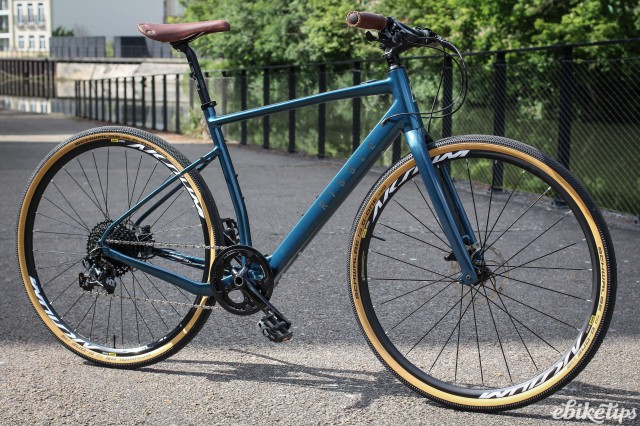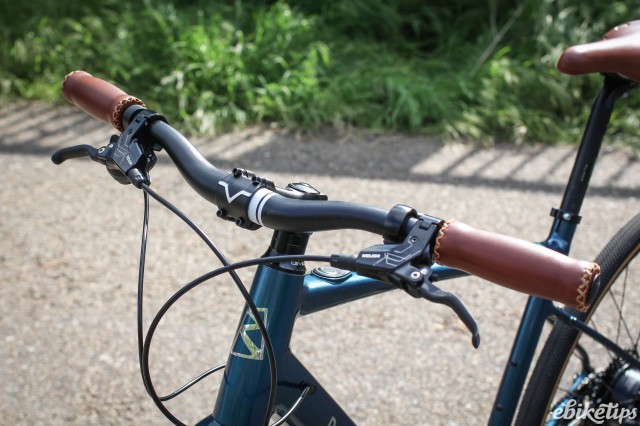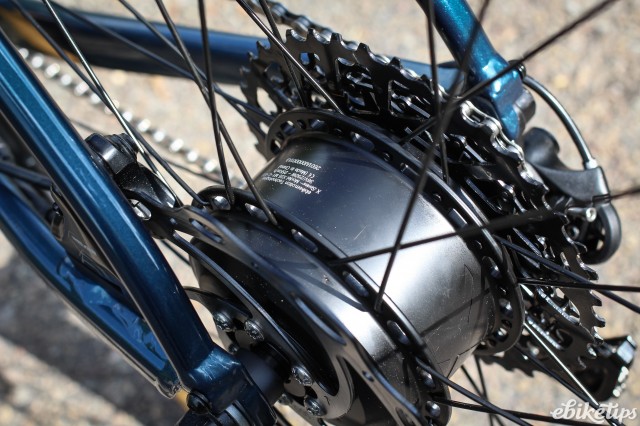Ribble Hybrid Al e

Overview
- Great looks
- High quality spec
- Good range and useful power
- Grips and saddle below par
- Charge port in a vulnerable position
Ribble’s Hybrid Al e is a very well-rounded entry into the assisted urban bike market. It’s well-designed, it rides well, it has an effective motor system and it’s very good value for money. If you want to look stylish around town and arrive where you’re going sweat-free, it’s definitely one to consider.
Buy the Ribble Hybrid AL e here
First things first: this is a lovely-looking bike. The alloy frame and fork are tidily built and well finished in a deep petrol blue. It’s built up with quality components throughout and the tan-wall Schwalbe tyres and retro leather-look grips and saddle really set it off. It looks great. Like the Ampler Stout and Juicy Bikes Ticket we’ve also tested here on eBikeTips, it doesn’t shout e-bike at all; it barely whispers it, in fact. Walk past the Hybrid Al e in a bike rack and you’d likely not clock it was a pedelec, it just looks like a classy city bike.
Those looks aren’t going to be worth much if the Ribble is a dog to ride... but the good news is that this isn't the case at all, it's an engaging city bike that’s quite a lot of fun to ride around town. The position is sporty without being overly aggressive, and the reasonably slack 71° head angle gives the steering a relaxed feel. The rigid fork has plenty of stiffness for precise control and the 640mm bars, although they’re a touch wide for some urban manoeuvres, give a comfortable and commanding position. The light overall weight of the bike contributes to its lively feel, and also means it’s easy to manhandle up steps or lift onto a bike rack.
The feel of the frame is direct but responsive: you’re not getting any suspension here except from the air chambers of the tyres, and as such the ride is firmer than some, but the bike isn’t uncomfortable for it. At least not because of the frame: I wasn’t overly impressed with the saddle or the handlebar grips. They both look nice, but the grips are a bit spongy and vague, and they work loose easily when they get wet. The saddle is the opposite: too hard for general riding without padded shorts if you’re doing anything over a few miles. Neither is a deal-breaker, but Ribble could do better for both your bum and your hands, and the contact points make the bike less enjoyable than it would otherwise be. The plastic Wellgo pedals won’t last too long, but they’ll do until you can get some nicer ones.
The ebikemotion X35 system is widely used now: if you’re looking for a lightweight e-bike then the odds are probably about 50:50 that it’ll use this motor. In terms of integration it’s arguably the neatest of the lot: the small motor is in the rear hub, and the non-removable battery is inside the down tube. The only on-bike control is a button at the front of the top tube. You can use it to turn the bike on and off, and it gives you information about the battery status and the assistance mode using an LED-illuminated ring around the button. This shows the battery state by default – white > green > amber > red as the charge decreases – and a press of the button will show the assistance mode, from white (off) up to red (maximum). A further press cycles through the modes. It’s simple to use and easy to access, although it’s not quite as convenient as a bar-mounted display. If you want to get more granular with your bike control you can connect the Ribble to the ebikemotion app, which gives you the ability to tune the assistance modes as well as offering navigation functionality.
The main selling point of the ebikemotion system is its weight: the whole system including a 250Wh battery weighs just 3.5kg, which contributes in major part to the Hybrid AL e’s 14kg overall weight. The motor is rated at 40Nm; that’s the same as a Bosch Active Line mid motor but in reality this system isn’t as powerful as any of the heavier mid motor systems. There’s enough assistance for most riding though. On my benchmark commuting climb (1.5km at 5% average, with a 12% section) it never really struggled; around the steepest bend I was in bottom gear and not moving especially quickly, but I wasn’t having to sweat to make it up the hill. On flatter and more rolling terrain the motor offers useful assistance for minimal-effort cruising.
The Hybrid Al e is plenty light and capable enough that you’ll likely spend some time above the assistance limit of 25km/h. If you do you’ll find that the bike is very happy cruising along without any help from the motor, and there’s very little noticeable drag from the rear hub. This is the same system that Ribble uses in their SLR e road bike () and I spent the majority of my time on that bike not being propelled by anything except my legs. If you wanted to you could probably do the same on this bike, although realistically the use case is different here.
With a small 250Wh battery you wouldn’t expect the Hybrid AL e to have a huge range. And it’s not huge, but it is impressive given what’s on board. The bike easily managed three days of my commute, which is around 9km and includes about 160m of climbing. As a general rule I tend to find that bikes use up around 100Wh of battery for one day’s commute, so three full round trips is well above par. Clearly the motor isn’t as powerful as some, and on steeper stuff you’re having to add some leg power of your own, but even so there’s plenty of capacity for even a long commute without any range anxiety. On the flat, in normal conditions and using the modes conservatively, you should expect to get well over 50km out of the bike. The charger is small and compact, so it’s easy to take it with you if you need more range, but on the other hand you’ll need to be somewhere where you can plug the whole bike in: you can’t remove the battery and take it inside to charge. Like all X35-equipped bikes I’ve tested so far, the charge port is on top of the bottom bracket which feels like a prime position for it to get filled up with rainwater and gunk. It has a rubber cover to protect it but it still feels vulnerable.
The level of spec on this bike, given the price, is impressive. SRAM’s 11-speed NX groupset performed very well during testing. It’s a single-ring setup, and Ribble hasn’t over-geared the bike: the 42-tooth chainring and 11-42 cassette give a good range of cruising gears and drop all the way down to a 1:1 ratio for steeper climbs. The thumb shifter has a positive feel, and is easy to use.
The Rever Attack-R Hydraulic Disc Brakes may not be the most well-known but they’re powerful and easy to modulate, and the short lever works well on the Level-branded 640mm alloy handlebar. You get 160mm rotors front and rear; I found the Tektro Lyra rotors a bit squealy in the wet but I never had any issues stopping the bike in any weather. Ribble’s Bike Builder specs the Hybrid Al e with Vision Trimax wheels but ours came with Mavic Aksium discs; either wheelset is a solid all-rounder at this price. Tyres are either Schwalbe Marathons – great for longevity but a bit wooden in their feel – or the tan-wall G-One Allround tyres that we used. They’re much better in terms of their ride feel and capable of some off-road use as well. They look good too.
Overall you’re getting a well-considered bike for your money here, and it’s good value. The obvious competitors we’ve tested are the Ampler Stout and the Juicy Bikes Ticket. Both did very well, and the Ribble is in the middle in terms of price. The Ticket is more budget-conscious in its spec and the ride was firmer than the Hybrid Al e. The Ampler is more expensive, but more fully-specced, with integrated lighting, mudguards and a kickstand. All of the three offer good reasons to buy; if it was my money I’d probably go with the Ribble which is, for me, the best combination of performance and value. Hopefully Ribble will soon offer some handlebar grip and saddle options on its Bike Builder to swap out the standard ones that you currently get, which I think are below par. When they do, it’ll be an even more compelling package.
2 comments
A direct competitor to the Ribble ALe seems to be the Specialized Vado SL. I'd be interested in the testers opinion of which would be most suitable a lightweight credit card tourer with some light off-road capability?
This bike comes seems well on point for an urban commuter but for a couple curious decisons. One, the bottom bracket seems uneccesarily high off the ground, which detracts from stability and increases the standover for a given stack/reach. Secondly, there's a bit of scitzophrenia with the finishing choices. On the one hand, you have the classic looking light brown leather seat and grips. On the other, you have road bike wheels with racy graphics. I'd have liked to seen them go one way or the other.











